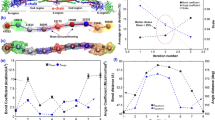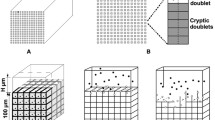Abstract
The clotting time (CT) of fibrinogen mixed with thrombin decreased, then increased with increasing fibrinogen levels. By contrast, log CT decreased monotonically with respect to the log level of activating enzyme (thrombin or reptilase). Here, the CT was determined over a large range of fibrinogen concentration (to 100 mg ml−1) at a fixed level of enzyme. A new parameter, [Fib]min, the minimal fibrinogen concentration required for thrombin or reptilase-instigated phase change (coagulation), was determined as [Fib]min=0.2±0.05 μM fibrinogen. A dynamic simulation program (Stella) was employed to organize simulations based on simple and complex coagulation mechanisms, which generated CT values. The successful simulation aimed at forming [Fib]min and “recognized” the binding of unreacted fibrinogen with intermediate fibrin protofibrils. The “virtual data” mimicked the biphasic experimental CT values over a wide range of concentrations. Fibrinogen appeared to act in three modalities: as a thrombin substrate; as a precursor of fibrin; and as a competitor for fibrin protofibrils. The optimized simulation may provide a basis for predicting CT in more complex systems, such as pathological plasmas or whole blood or at high concentrations encountered with fibrin sealant.







Similar content being viewed by others
References
Alving BM, Weinstein MJ, Finlayson JS, Menitove JE, Fratantoni JC (1995) Fibrin sealant summary of a conference on characteristics and clinical uses. Transfusion 35:783–790
Balazs AC, Anderson C, Muthukumar M (1987) A computer simulation for the aggregation of associating polymers. Macromolecules 20:1999–2003
Bale MD, Jamney PA, Ferry JD (1982) Kinetics of formation of fibrin oligomers. II. Size distribution of ligated oligomers. Biopolymers 21:2265–2277
Bertina RM (2003) Elevated clotting factor levels and venous thrombosis. Pathophysiol Haemost Thromb 33:395–400
Beutler E, Lichtman MA, Coller BS, Kipps TK, Seligsohn U (eds) (2001) Williams hematology, 6th edn. McGraw-Hill, New York
Gentry R, Ye L (1995) Modeling surface mediated enzymatic reactions in a flow system. In: Brebbia CA, Hart TT, Power H (eds) Computer simulations in biomedicine. CML Publications, pp 225–323
Gentry R, Ye L, Nemerson Y (1995) Surface mediated enzymatic reactions: simulations of tissue factor activation of Factor X on a lipid surface. Biophys J 69:362–371
Gorodetsky R, Vexler A, Shamir M, An J, Levdansky L, Shimeliovich I, Marx G (2003) New cell attachment peptide sequences from conserved epitopes in the carboxy termini of fibrinogen. Exp Cell Res 287:116–129
Hantgan R, Mcdonagh J, Hermans J (1983) Fibrin assembly. Ann NY Acad Sci 408:344–366
Higgins DL, Lewis SD, Shafer JA (1983) Steady state kinetic parameters for the thrombin-catalyzed conversion of human fibrinogen to fibrin. J Biol Chem 258:9276–9282
Husain SS, Weisel JW, Budzynski AZ (1989) Interaction of fibrinogen and its derivatives with fibrin. J Biol Chem 264:11414–11420
Jamney PA, Erdile L, Bale MD, Ferry JD (1983) Kinetics of fibrin oligomer formation observed by electron microscopy. Biochemistry 22:4336–4340
Larsson U, Blomback B, Rigler R (1987) Fibrinogen and the early stages of polymerization to fibrin as studied by dynamic light scattering. Biochem Biophys Acta 915:172–179
Lewis SD, Shields PP, Shafer JA (1985) Characterization of the kinetic pathways for the liberation of fibrinopeptides during assembly of fibrin. J Biol Chem 260:10192–10199
Martinelli L, Sheraga HA (1980) Steady-state kinetic study of the bovine thrombin–fibrinogen interaction. Biochemistry 19:2342–2350
Marx G (1988) Mechanism of fibrin coagulation based on selective, cation-driven, protofibril association. Biopolymers 27:763–774
Marx G (1990) Modeling (proto)fibrin coagulation. Biopolymers 29:1233–1241
Marx G, Blankenfeld A (1993) Kinetic and mechanical parameters of pure and cryoprecipitate fibrin. Blood Coagul Fibrinolysis 4:73–78
Marx G, Mou X (2002) Characterizing fibrin glue performance as modulated by heparin, aprotinin and Factor XIII. J Lab Clin Med 140:152–160
Marx G, Ben-Moshe M, Magdassi S, Gorodetsky R (2004) Fibrinogen C-terminal peptidic sequences (haptides) modulate fibrin polymerization. Thromb Haemost 91:43–51
Merli G (2005) Diagnostic assessment of deep vein thrombosis and pulmonary embolism. Am J Med 118(suppl 8A):3S–12S
Nelb GW, Kamykowski GW, Ferry JD (1980) Kinetics of the ligation of fibrin oligomers. J Biol Chem 255:6398–6402
Nieuwdorp M, Stroes ES, Meijers JC, Buller H (2005) Hypercoagulability in the metabolic syndrome. Curr Opin Pharmacol 5:155–159
Preissner KT, Rotker J, Scimayr E, Fasold H, Muller-Berghaus G (1985) Reversible interactions of fibrin and fibrinogen: an ultracentrifugation study. In: Henschen A, Hessel B, McDonagh J, Saldeen T (eds) Fibrinogen—structural variants and interactions. Walter de Gruyter, Berlin, pp 130–139
Radosevich M, Goubran HA, Burnouf T (1997) Fibrin sealant: scientific rationale, production methods, properties and current clinical use. Vox Sang 72:133–143
Reinhart WH (2003) Fibrinogen—marker or mediator of vascular disease? Vasc Med 8:211–216
Rotker J, Preissner KT, Muller-Berghaus G (1986) Soluble fibrin consists of fibrin oligomers of heterogeneous distribution. Eur J Biochem 155:583–588
Sato H, Nakajima A (1984) Kinetic study of the initial stage of the fibrinogen–fibrin conversion by thrombin: (I) application of mathematical treatment to turbidimetrical method. Thromb Res 33:645–651
Sonntag H, Strenge K (1987) Coagulation kinetics and structure formation. Plenum Press, New York
Usero JL, Burguillo FJ, Izquierdo C, Delarco A, Herraez MA (1985) The fibrinogen–fibrin complex: stoichiometry and negative cooperativity. Thromb Res 39:379–386
Weisel J (2005) Fibrinogen and fibrin. Adv Protein Chem 70:247–299
Weisel JW, Nagaswami C (1992) Computer modeling of fibrin polymerization kinetics correlated with electron microscope and turbidity observations: clot structure and assembly are kinetically controlled. Biophys J 63:111–128
Wilf J, Minton AP (1986) Soluble fibrin–fibrinogen complexes as intermediates in fibrin gel formation. Biochemistry 25:3124–3133
Acknowledgement
This work was supported by MX Associates (New York, NY 10003), who retain rights to further develop and commercialize the simulation program.
Author information
Authors and Affiliations
Corresponding author
Appendix: Simulation of complex mechanism of fibrinogen coagulation
Appendix: Simulation of complex mechanism of fibrinogen coagulation
(Copyright MX Associates, New York, reprinted with permission)

Rights and permissions
About this article
Cite this article
Marx, G. Simulating fibrin clotting time. Med Bio Eng Comput 44, 79–85 (2006). https://doi.org/10.1007/s11517-005-0007-z
Received:
Accepted:
Published:
Issue Date:
DOI: https://doi.org/10.1007/s11517-005-0007-z




